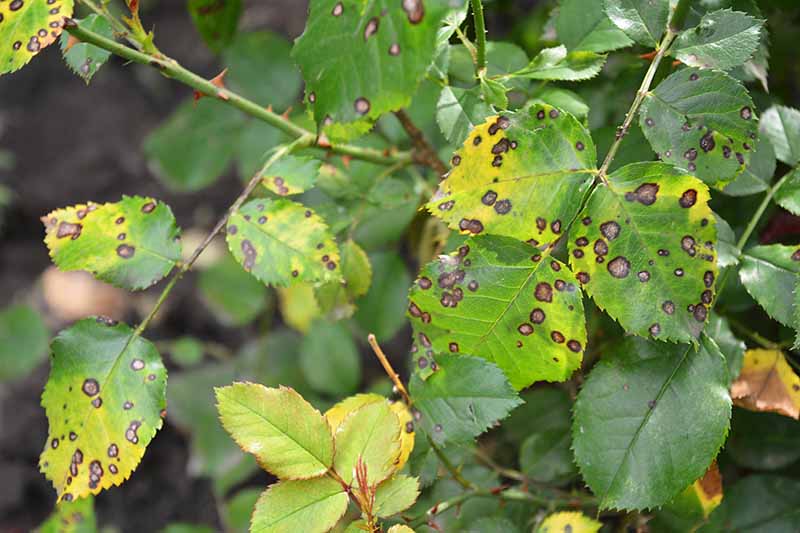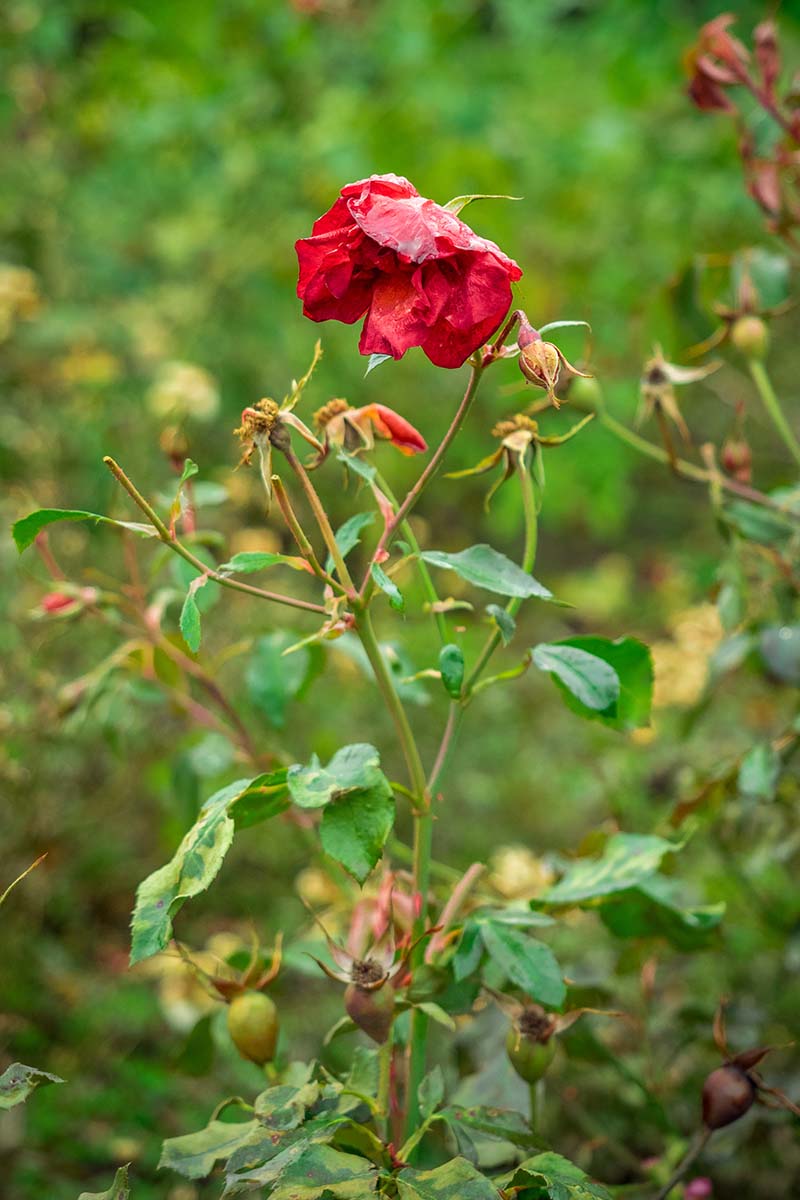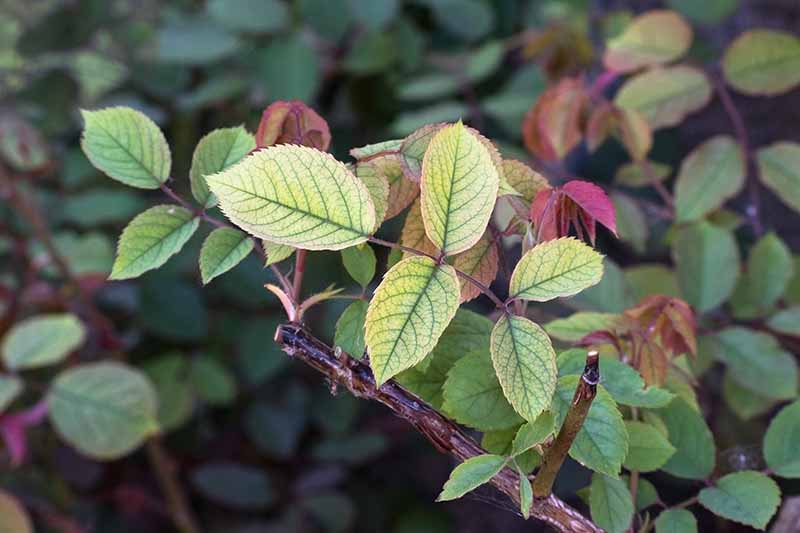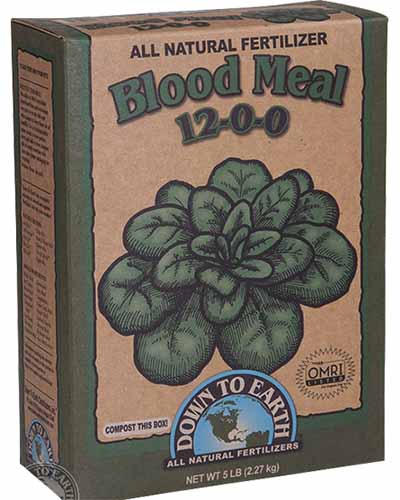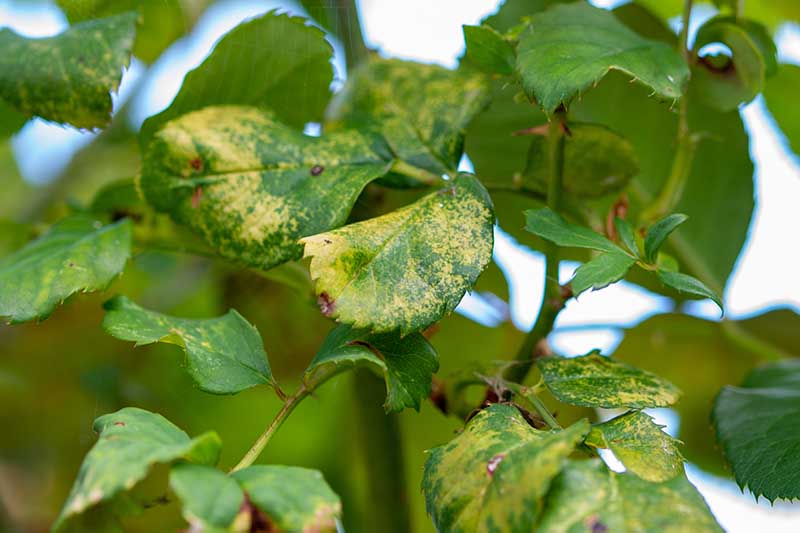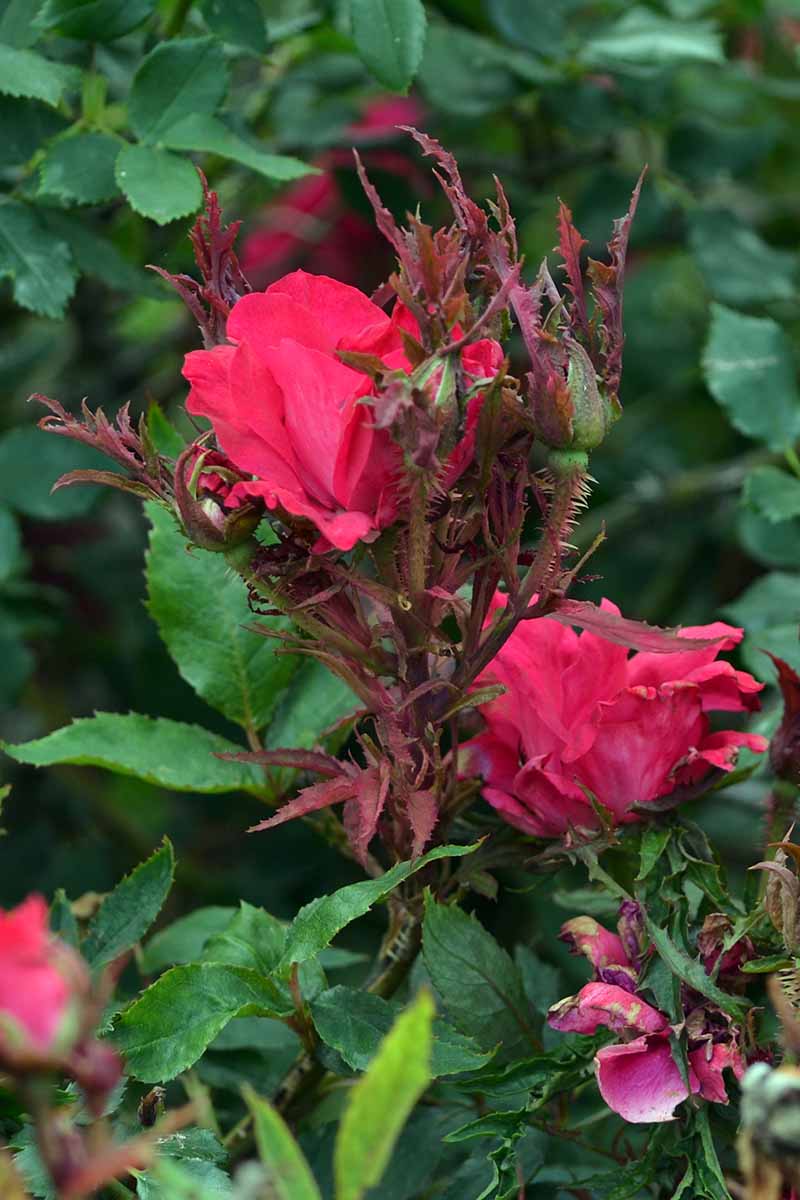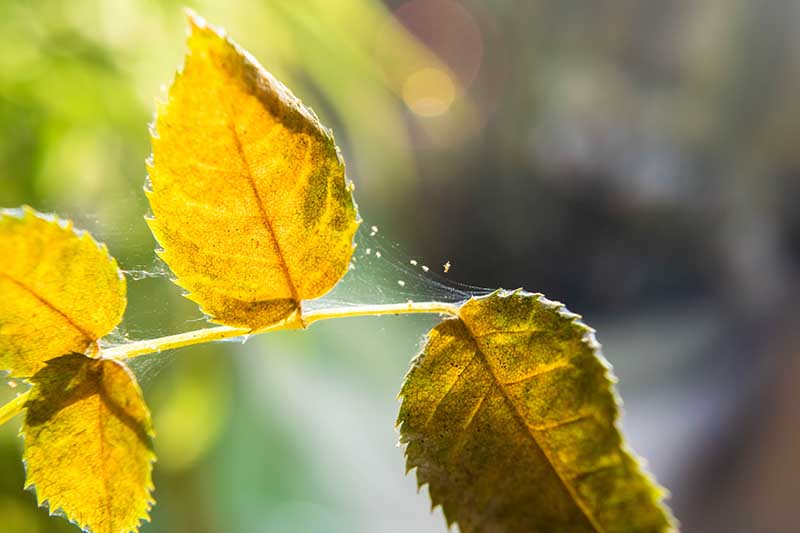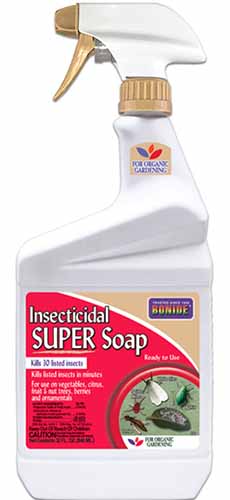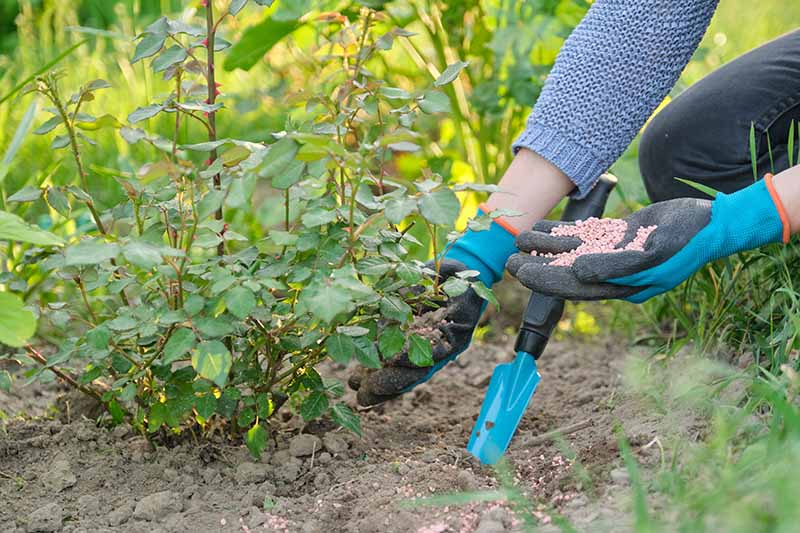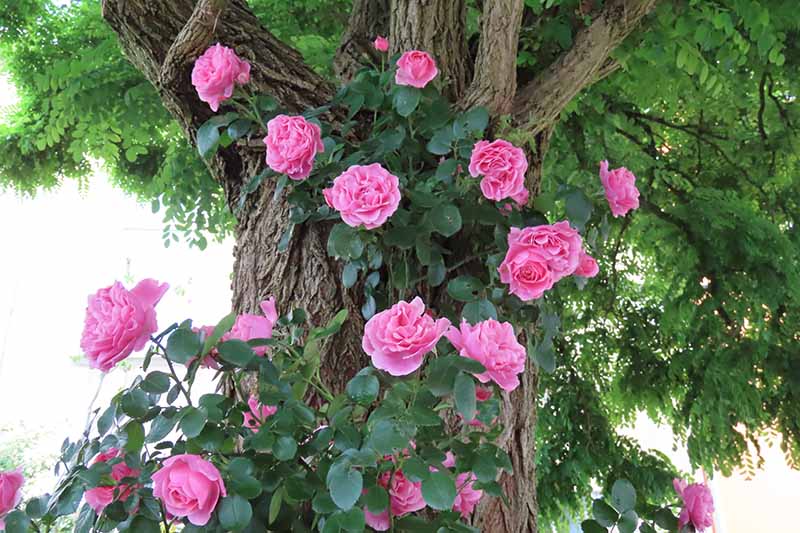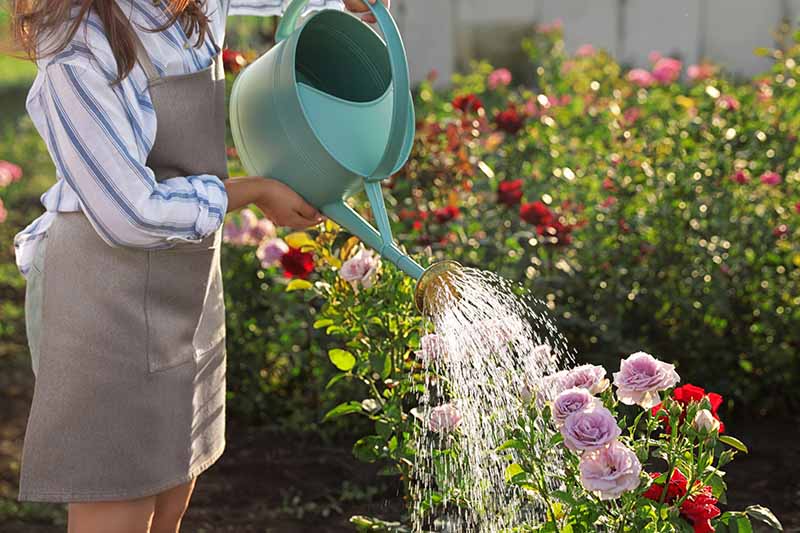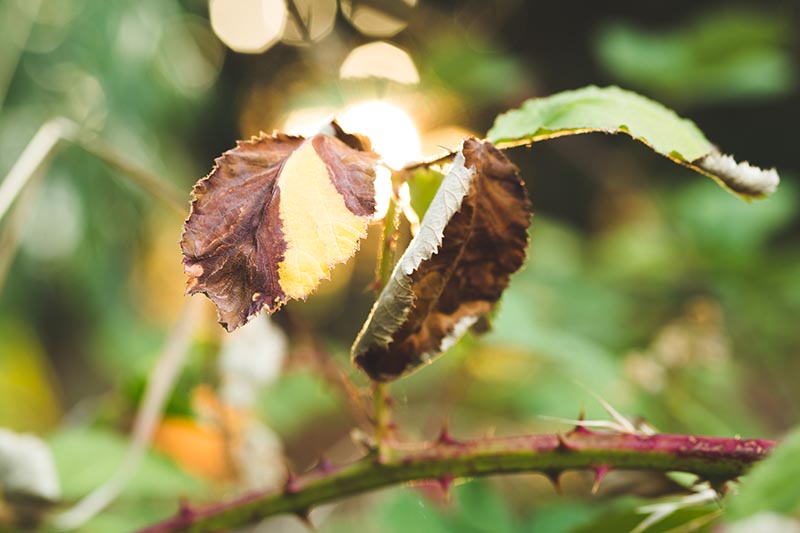Your grapevines could warn you that they’re being attacked by a fungus and your roses could alert you to a serious thrips infestation before you ever saw any signs of it. But alas, plants can’t talk. So we’re left looking out for clues that something is wrong. Yellow leaves? They’re a definite sign that all is not well with your rose. If it could talk, it would be yelling, “Helllllp!” We link to vendors to help you find relevant products. If you buy from one of our links, we may earn a commission. That’s where this guide comes in. Up ahead, we’ll discuss the most common causes of yellow leaves on your roses and what to do about them. Here’s what you can expect: Yellow leaves aren’t a death sentence for your plant. But the faster you figure out what the problem is, the better the chances are of fixing it, so let’s get started.
1. Black Spot
Black spot is a disease caused by a fungus called Diplocarpon rosae. You’ll know if your leaves are yellowing because of this disease and not something else if you can see small black spots forming all over the upper surface of the foliage. After the black spots develop, the foliage on the plant turns yellow and eventually falls to the ground. This problem is extremely common, and every rose grower will probably encounter it at some point. To learn more about how to identify and deal with it, read this section of our guide to identifying and treating common rose diseases.
2. Drought Conditions
Drought conditions cause foliage to turn yellow and even drop off the plant. Typically, you’ll also see the tips of the leaves turning brown. While failing to receive enough water is the most obvious cause, drought conditions can also be caused by drying winds, or sun being reflected off of nearby surfaces like windows or metal siding. Sunburn or wind can rapidly evaporate the moisture in the upper parts of the plant, while not getting enough water reduces the amount of moisture available to the roots, and so less can be moved throughout the rest of the plant. Sandy soil can also contribute to the problem. Sandy earth doesn’t hold water as well as clay or something in between sandy and claylike. In all cases, providing more water can help, particularly during periods of high heat or windy conditions. Adding an inch-thick layer of wood chips, compost, or straw mulch to the top of the soil around your plants can also help the soil retain moisture. The amount of water your rose needs varies by type, but typically, you only want the top inch or two of soil to dry out in between waterings. If your rose starts to droop, it’s too dry.
3. Iron Deficiency
If the foliage on your shrub – particularly young leaves – is turning light green or yellow, but the veins remain dark, this is what’s known as chlorosis, and it’s likely that they have an iron deficiency. That doesn’t mean you should run out and get some iron to add to the soil though. The best way to address this problem is to test your soil first. Though they are less common issues, a zinc or magnesium deficiency can look similar. You need to check and be sure that this is what you’re dealing with, then adjust the pH of your soil, if necessary. These plants prefer a soil pH right around 6.0 to 6.5. Iron isn’t as readily available to most plants in soils with a high pH level. Anything alkaline that’s above 7.0 will have reduced iron availability. You can lower the pH by adding sulfur, following the manufacturer’s directions. If you’re sure the problem is low iron and your soil pH is correct, either naturally or through amending it, then you can add iron to the soil.
4. Nitrogen Deficiency
If a rose is deficient in nitrogen, it will exhibit reduced chloroplast and chlorophyll synthesis. As a result, the leaves may look pale yellowish-green and thin. SaferGro Biomin Iron A foliar spray will address the iron shortage in the short term, while repeated soil applications will address it over a longer period. Pick some up at Arbico Organics if low iron is the problem. Read more about identifying and treating iron deficiency in roses here. The yellowing usually starts with older leaves, and new leaves will be weak, small, and spindly. As with an iron deficiency, the first step is to test your soil. The wrong pH can make nitrogen less available to your roses. If your soil test indicates a lack of nitrogen, you’ll need to add it to the soil.
5. Rose Mosaic Virus
I have to confess that I think the symptoms of rose mosaic disease are kind of pretty. Down to Earth Blood Meal Just follow their recommended application instructions to give your plants the boost they need. Need to purchase some? Arbico Organics carries DTE blood meal in half-pound, five-pound, 20-pound and 50-pound packages. It causes the foliage on the plant to become stippled or splotched yellow and green. Leaves might turn greener as the season progresses. There are numerous viruses that cause this disease, including Rose Necrotic Ringspot Virus and Apple Mosaic Virus. Besides making plants decidedly unique looking, the disease can also cause stunted growth. Your best option is to just let it be. There is no cure and it doesn’t usually impact plants dramatically. Pull the plants if it bothers you. Fortunately it doesn’t spread easily to other roses, but infected plants should be avoided if you plan to do your own grafting. Find more information on rose mosaic disease here.
6. Rose Rosette Disease
Yellowing leaves are one of the early symptoms of this extremely strange disease. Rather than becoming pure yellow, the leaves will have mottled yellowing, which may or may not also include some red coloration. As the leaves mature, they’ll remain discolored and they’ll also become distorted, with an elongated shape or curling. You’ll also see more thorns form than usual, and reddish witches’ broom growth. Learn more about this disease in our guide here.
7. Spider Mites
Spider mites are tiny arachnids in the Tetranychidae family, and they are extremely common. A small infestation isn’t a big deal, but larger infestations can cause the leaves to turn yellow and drop from the plant. This can look much like drought stress, so examine your plants closely and look for the telltale fine webbing covering your plant that serves as a common sign of their presence. Once the leaves are turning yellow and falling, you already have a pretty serious problem on your hands. You’re going to want to take a multi-pronged approach. Read more about dealing with these common garden pests in our guide. Bonide Insecticidal Super Soap At the same time, at least 24 hours after spraying the plants with water, apply an insecticidal soap like Bonide’s Super Soap, available at Arbico Organics in quart-size spray bottles. After you treat the plants, introduce beneficial predators like assassin bugs, lacewings, ladybugs, or minute pirate bugs to take care of any of any inevitably remaining mites.
8. Too Much Fertilizer
Too much fertilizer can cause leaves to turn yellow. That can mean you’re applying fertilizer too often, or applying too much of it at a time. The foliage turns yellow because excess fertilizer raises the level of salt in the soil. To address the problem, first test your soil. You might not need as much fertilizer as you think. Then, be sure to follow the manufacturer’s recommended application timing and amounts. Container-grown plants are particularly susceptible to over-fertilization because there is less soil available to the roots of the plant. For that reason, be extremely cautious when fertilizing your container roses. While they need more fertilizer than plants grown in the ground, it’s easy to overdo it. If it’s too late and you’ve already added too much fertilizer, flush the soil with water. To do this, over the next few days, add as much water as your shrub can stand to the soil. Watch for wilting or the soil becoming completely wet and muddy. If that happens, stop watering.
9. Too Much Shade
Most roses need full sun, though some can tolerate partial shade. If the foliage doesn’t receive the light it needs, it can’t photosynthesize properly to create that familiar green color. If you start noticing yellow leaves on your plant and suspect this may be the case, use a light meter or watch your plant to see how much light it is receiving throughout the day. If your plant isn’t getting enough light, determine what is blocking the rays. If it’s nearby trees or shrubs, prune them. If that’s not possible because the shade is coming from a building or a tree that can’t be thinned, you’ll need to move your rose. If the leaves on just the bottom part of the plant are turning yellow, it could be that the foliage up top is too dense and light isn’t reaching them. In that case, it’s time to take out the pruners and thin your plant out a bit.
10. Too Much Water
When a plant receives too much water, the roots can’t access the oxygen they need to survive. As a result, the plant stops moving water and nutrients to the leaves, and the foliage turns yellow as the plant starts to die. With roses, you want to err on the side of soil that’s too dry rather than too wet. Roses need about two inches of water per week. If you receive that much rain in a week, don’t add more water. A rain gauge can help you determine how much water your plants are getting so you can adjust your watering schedule accordingly. If you’re sure you are watering appropriately, it’s time to check your soil. Soil with poor drainage or heavy clay retains water and can suffocate roots. Your best bet is to dig up the plant, and add plenty of well-rotted compost to the earth before replanting. If your soil is really heavy or poor in terms of drainage, you might want to consider growing in a container or a raised bed instead. Yellowing leaves are a clear indicator that you need to take action. Once you’ve gotten the situation under control, come back and share your experiences with the rest of us. You can never be too well-informed in the fight against gardening problems. Hopefully, this guide helped you feel armed to figure out what’s wrong and how you can fix it. If so, we have some other useful information on growing roses in your garden to read next:
Growing Roses 101: Getting StartedHow to Control Aphids on RosesHow to Propagate Roses from CuttingsWhat Are David Austin English Roses?

